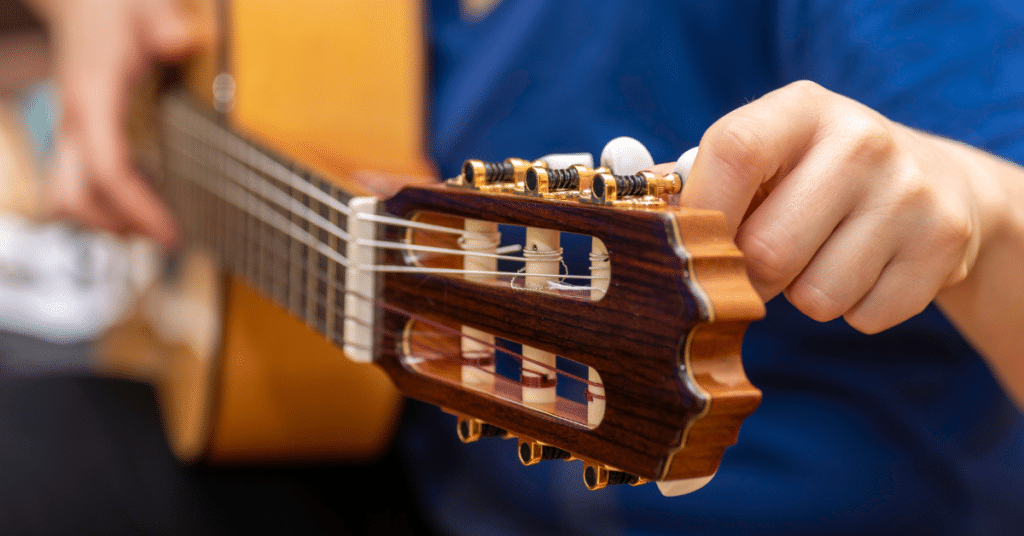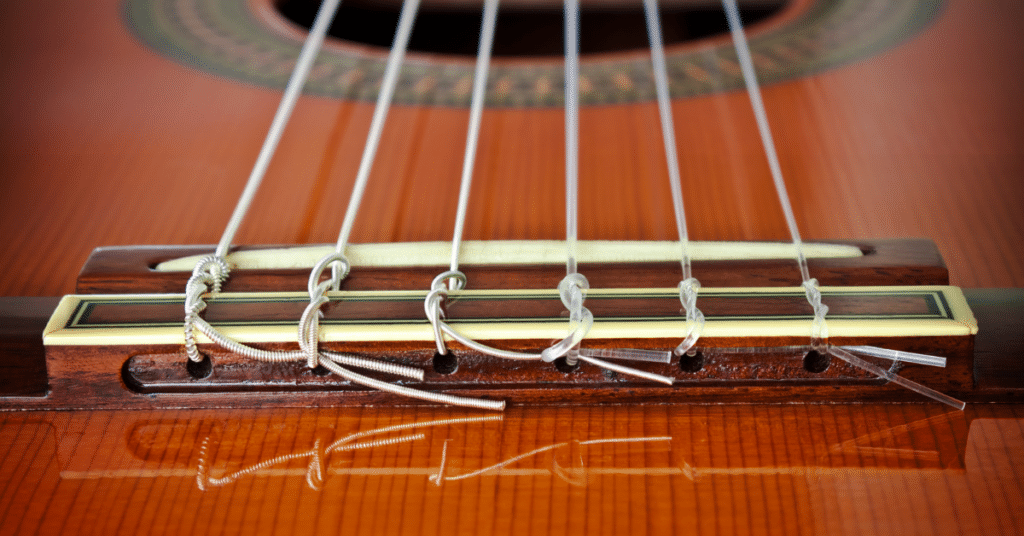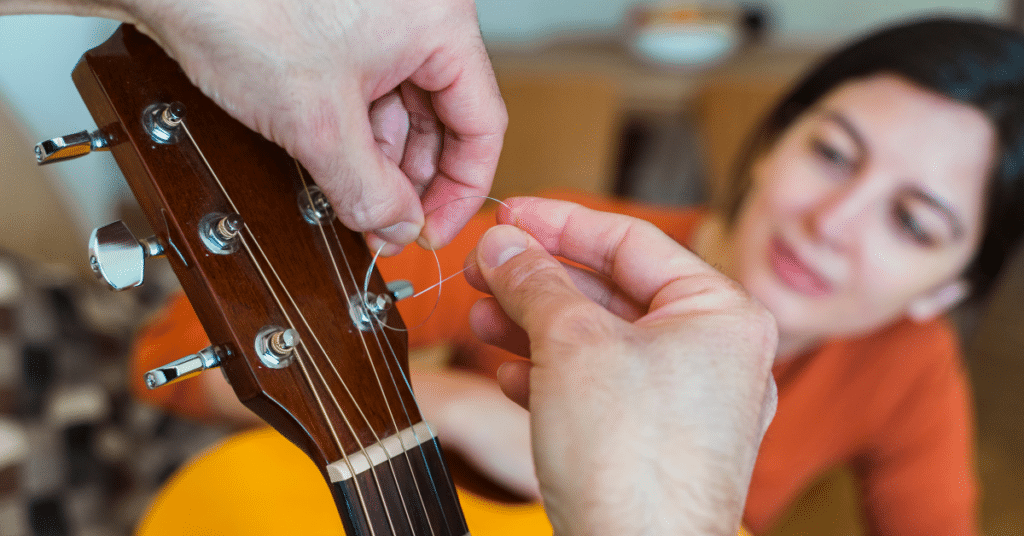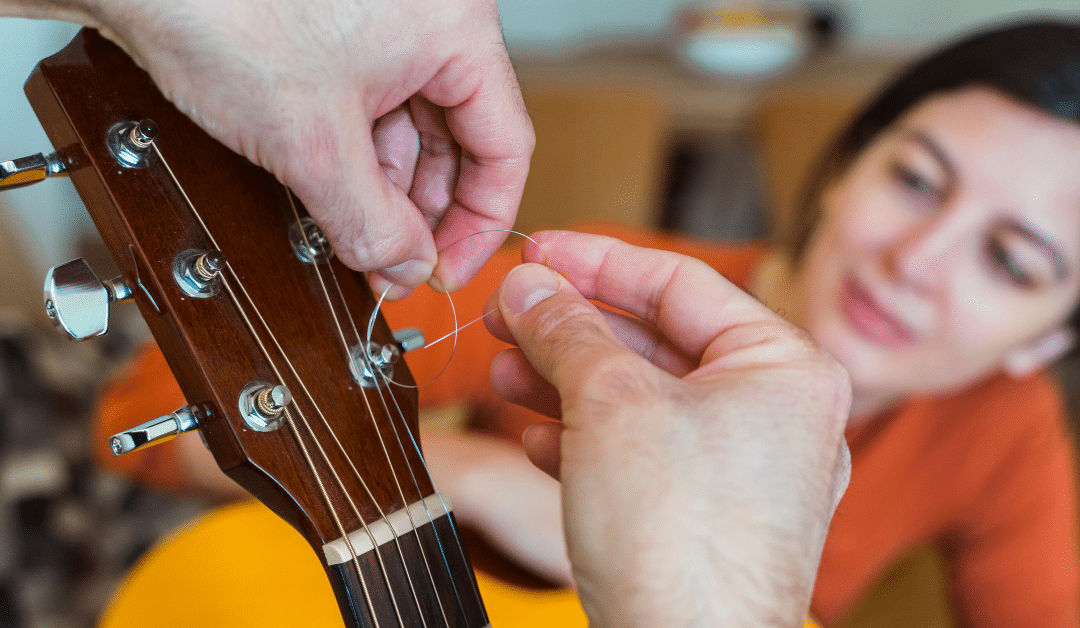Have a guitar string break, let’s show you how to replace guitar strings. Replacing the strings on the guitar can be a journey for those new to the instrument. The process can take hours if you are out of practice, and can be more costly than you think if done carelessly. After a few times doing so it may only take a few minutes to change all six strings, but it is important to take into account several factors, from the purchasing process to the assembly, so that the functional result is as expected.
Video on How to Replace Guitar Strings:
Easily Change Your Acoustic Guitar Strings
Guitar String Products Mentioned in the Guide:
The guitar and its strings
The guitar is one of the easiest stringed instruments to handle when it comes to tuning, mounting, or removing strings. In general, its mechanical system to tighten or loosen the strings is very simple and does not require much dexterity to raise or lower their tones, as turning the pegs is enough. Certainly, we could find guitars that require a little more effort for that task, but they are still trivial compared to other instruments. The piano, for example, is an instrument that requires greater dedication in the handling of its strings, not only to guarantee the right tonalities but also to avoid damaging the delicate internal mechanism.

When thinking about changing the guitar strings, it is necessary to consider several aspects related to the type of guitar you own, the type of sound you want to obtain, and the budget you can afford. We could make the mistake of going to a music shop and choosing any kind of strings. We might be able to get a set of strings suited to the quality of our instrument, but we might also end up with one that ultimately doesn’t exploit the full capacity of our guitar.
Tuning the strings on the guitar
The tuning of the strings on the guitar should be known to any guitarist. Not only because of issues related to music theory but also because each string is another piece of the guitar. And, like any part, we may need to repair one or remove it and replace it with a new one. This way, when we go to the music store we will know exactly what we are looking for.
The strings of the guitar, from the sixth (the lowest) to the first (the highest) are tuned as:
- Sixth string – E String
- Fifth string – A String
- Fourth string – D String
- Third string – G String
- Second String – B String
- First string – E String
This way, if we need to replace only the third string of the guitar, for example, and we would just go to the music store and buy the guitar G string. In turn, we could also be guided by the appearance of each of the strings.
The lower pitch strings (sixth, fifth and fourth) are usually thicker and commonly found covered with bronze, while the higher pitch strings (third, second, and first) can be found in nylon, softer, and prone to break at high tensions. However, the shape and material of the strings will vary according to the type of guitar they are used for.
Different guitars, different strings
Guitars will not always require a standard string type. Of course, if we have no other option we can put any set of strings that fit, but we must be attentive to the sonority that we get at the end. A classical guitar, or Spanish guitar, usually uses nylon strings, so its sonority will be softer than that of an acoustic guitar, whose strings may be made of metal, giving more strength to its sound. We could put metal strings on a classical guitar and produce good sounds, but both the headstock and its bridge might not resist the high tension that metal strings require and end up bending the neck or breaking the soundboard.
On the other hand, the musician may also consider his own playing performance when selecting the type of strings. For example, if the musician does not have much experience playing the guitar and has an acoustic guitar, he might choose to buy nylon strings, instead of metal strings, so as not to mistreat his fingers when playing with hard and tense strings.
Types of strings for acoustic guitar
We must understand that both the classical guitar and the acoustic guitar are both acoustic guitars’ because of their functionality. The acoustic guitar is the one that emits the sound thanks to its own internal repercussion. The denotation of ‘classical’ and ‘acoustic’ refers to the way the guitar is made, the strings it has, and thus the kind of sound it emits. In fact, we could find other types of guitars with the same way of emitting the sound (acoustically), such as the flamenco guitar, the jumbo guitar, or the Italian guitar.
So, due to the diversity of the instrument, we can categorize the strings based on their various characteristics.
Low tension Strings
Low tension strings are usually very light and not very dense, so they break more easily. They are ideal for fragile guitars as they do not exert much force between the headstock and the bridge.
D’Addario EJ16-3D Phosphor Bronze Acoustic Guitar Strings, Light Tension – Corrosion-Resistant Phosphor Bronze, Offers a Warm, Bright and Well-Balanced Acoustic Tone – Pack of 3 Sets
4 used from $19.46
Features
- WARM, BALANCED TONE - Phosphor Bronze wrap wire provides tried-and-true D’Addario acoustic tone, with beautiful balance and warmth suitable for all musical genres.
- EARN REWARD POINTS - D’Addario Phosphor Bronze acoustic guitar strings come with a code on the recyclable VCI bag, which you can register to earn Players Circle points.
At the same time, they allow a more fluid interpretation of the hand on the frets, since it is not necessary to make a lot of pressure to achieve the desired sounds. This type of string is perfect for the inexperienced musician who has not accustomed his fingers to the continuous friction with the guitar.
High Tension Strings
High tension strings are usually made of a denser material, so they require more tension to get in tune. This will produce a higher pressure not only on the string but on the whole instrument.
D’Addario Pro-Arte Nylon Classical Guitar Strings, Hard Tension (EJ46)
Features
- STANDARD CLASSICAL TONE - Pro -Arte’ Nylon strings offer the standard classical guitar tone many players hold dear.
- RESPONSIVE PLAYABILITY & WARM TONE - Utilizing our multi-filament nylon core basses and clear nylon trebles, Pro-Arte’ Nylon strings provide beautifully responsive playability and sweet, mellow tonal warmth.
- TIE ENDS - This set features tie-ends, nylon monofilament material, and silver-plated copper wrap wire.
- EARN REWARD POINTS - D’Addario Pro-Arte’ Nylon classical guitar strings come with a code on the recyclable, resealable VCI bag, which you can register to earn Players Circle points.
- MADE IN THE USA – Our classical strings are made in the USA—drawn to exacting specifications at our New York production facility.
Care must be taken, when putting high tension strings on the guitar. The bridge, bridge pin, and headstock must be sufficiently strong, otherwise, it could be detrimental to the instrument over time. High Tension strings strings are very common among more experienced players since it requires some extra effort with the hands to achieve a clean sound.
D’Addario EJ16-3D Phosphor Bronze Acoustic Guitar Strings, Light Tension – Corrosion-Resistant Phosphor Bronze, Offers a Warm, Bright and Well-Balanced Acoustic Tone – Pack of 3 Sets
4 used from $19.46
Features
- WARM, BALANCED TONE - Phosphor Bronze wrap wire provides tried-and-true D’Addario acoustic tone, with beautiful balance and warmth suitable for all musical genres.
- EARN REWARD POINTS - D’Addario Phosphor Bronze acoustic guitar strings come with a code on the recyclable VCI bag, which you can register to earn Players Circle points.
How to Choose Acoustic Guitar Strings
Based on the above characteristics for strings, the following tips can be followed when purchasing your guitar strings:
- Check that the size of the strings is suitable for the guitar, as many sizes of guitars are available. It is helpful if new strings are long enough so that, in the event of a breakage, they can be fitted with the unused portion of the string.
- Check the material they are made of. Nowadays the most commonly used strings on acoustic guitars are coated with bronze. They have a clean sound and tend to last for years. Normally two variations are available, one in bronze and the other in phosphor bronze, the latter being more resistant and therefore more durable.
- The tension of the strings is usually understood as the calibre of the strings. So, if you are looking for low tension strings, the ideal would be a set of strings in which, taking the sixth string as a reference, it has a gauge lower than 010. On the other hand, if what you want is a set of high tension strings, it is advisable, taking the sixth string as a reference, to opt for a set of strings in which this string has a gauge of 012 or 013.
How to replace guitar strings on acoustic guitar
Replacing the strings on the acoustic guitar can be a chore the first few times. However, with a little practice, it can become trivial. If you are inexperienced and are afraid of damaging the instrument due to lack of practice, the following steps can be taken:
- Loosen all the old strings on the guitar, if you have them. It is advisable to decrease the tension of all the strings slowly, with the help of the pegbox, so that the expansion of the wood does not put pressure on the pegbox and the bridge in an unbalanced way.
- Once the strings have loosened sufficiently, using the tuning pag remove them from the pegbox and then from the knot in the bridge, one at a time.
- Having the guitar without strings, some people take the opportunity to clean the grease left by their hands on it. It is an optional step that can be done with some wood cleaning cream. This is to preserve the material of the guitar.
D’Addario Pro-Arte Nylon Classical Guitar Strings, Light Tension (EJ43)
$10.99 in stock12 new from $10.99Free shippingAmazon.comas of April 26, 2024 2:29 amD’Addario EJ16-3D Phosphor Bronze Acoustic Guitar Strings, Light Tension – Corrosion-Resistant Phosphor Bronze, Offers a Warm, Bright and Well-Balanced Acoustic Tone – Pack of 3 Sets
$23.99 in stock9 new from $22.99
4 used from $19.46Amazon.comas of April 26, 2024 2:29 amD’Addario Pro-Arte Nylon Classical Guitar Strings, Hard Tension (EJ46)
$10.99 in stock22 new from $10.99Free shippingAmazon.comas of April 26, 2024 2:29 amD’Addario EJ48 80/20 Bronze Pro-Arte Nylon Classical Guitar Strings, Hard Tension
$9.99 in stock5 new from $9.99Free shippingAmazon.comas of April 26, 2024 2:29 amMusic Nomad MN108 Premium Guitar Care 5-Piece Kit
$29.99 in stock8 new from $28.99Free shippingAmazon.comas of April 26, 2024 2:29 am
- Take one of the new strings, insert one of its ends into the corresponding hole of the bridge, and tie it (as shown in the following picture). This step may vary in some acoustic guitars that do not have this same type of bridge, but one in which the strings are wound into buttons and pressed into holes. In any case, the aim is to fix the strings on the bridge.

- When the string is tied at the bridge, the other end of the string is taken and brought to the pegbox. The common shape of the string holders in the pegbox is that of a cylinder with a hole into which the string is inserted and then wound around it. This cylinder can be either parallel or perpendicular to the guitar headstock (see guitar headstock).

- After winding the string, it is tightened a little with the help of its respective tuning peg in order to fix it while repeating the process with the remaining five strings.
- Once the six strings are mounted, they are properly tensioned to achieve the desired tuning.
It is important to take into account that once the new strings are mounted on the guitar they will need some time to adapt to the tension. Because of this, it will be normal for them to lose their tuning by themselves, forcing the musician to tighten them again. On the other hand, old strings can be stored and kept as spare strings if they are not too deteriorated. They can be cleaned with a dry cloth to remove any traces of grease and can be stored in a slightly damp place.
The electric guitar and its strings
The electric guitar, unlike the acoustic guitar, does not emit sound through the repercussion of sound waves, but through the vibration of its strings and the translation of these vibrations into an electronic system. Therefore, changing your strings may require additional tools, such as pliers or a screwdriver. The principle for changing the strings is the same as for acoustic guitars, but there are certain points to keep in mind:
- The bridge of the electric guitar works differently. Normally electric guitar strings come with a small plug at one end. Then, instead of tying the strings to the bridge, they are inserted into holes located at the back, go through the guitar, and come out through the front, being secured by the block of their tips. This is often referred to as a bridge pin. At the same time, these holes are usually sealed with a cap, which is why the screwdriver is necessary.
- Having a string coming out of the front of the guitar, take its tip and take it to the pegbox, winding it on its respective peg. It is common not to let all the remaining string go around the tuning peg. Instead, they are usually cut with pliers so that no piece of string is left dangling.
- Electric guitar strings are usually made of steel. Thus, they can be expected to be hard and hurt the hands of the beginner musician, as they will have a high calibre.
Final tips
- When changing strings, take into account the final purpose of the instrument. It is good to think about what kind of sonority you are looking for, what skills you have to achieve it and how much you can spend on it.
- Do not rush the process of changing the strings just for lack of patience. It is a task that must be carried out calmly so that the work is not counterproductive, taking the time now will prevent string slippage and poor sound in the future.
- If instead of changing all the strings you want to change only one or two, you must take into account that the sonority might not be very good, since you are mixing the lucidity of new strings with the oldness of the used strings. Therefore, when a string change is required, it is advisable to change all the strings at the same time. And if the old strings are still in good condition, they can be left as spare strings.






